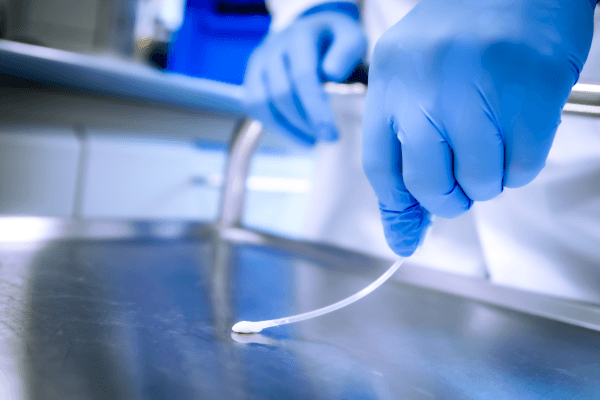
Chromogenic Reactions
Optimize food safety testing with Chromogenic Reaction Technology. Achieve rapid, precise, and reliable detection of contaminations in food production environments.
Chromogenic-based Hygiene and Food Safety Testing: Reliable and Convenient Detection of Contaminations
In routine diagnostic testing for food safety and environmental monitoring, simplicity and reliability are key. Chromogenic-based Reaction Technology has long been a trusted method for the rapid identification of microorganisms, offering an efficient and straightforward approach that yields dependable results. Whether used for ensuring food safety or maintaining clean environments, this technology stands out for its speed and ease of use without sacrificing accuracy.
What are Chromogenic Reactions?
A Chromogenic-based Reaction is a widely-used method in microbial diagnostics, renowned for its simplicity and reliability. At its core, this method relies on chromogenic substrates—compounds that react with specific enzymes produced by target microorganisms. When these enzymes are present, they catalyze a reaction that results in a distinct color change, allowing for the rapid and straightforward identification of the organism or target.
This approach has become a staple in food safety testing and environmental monitoring, where speed and accuracy are crucial. Its ease of use means that even in high-throughput settings, results can be obtained quickly without the need for complex procedures. Chromogenic Reactions continue to be favored by industry professionals for their ability to deliver reliable results efficiently, ensuring the highest standards of safety and quality are met.
How Does Chromogenic-based Testing Work?
Chromogenic Reactions leverage color-changing substrates to provide an easy and reliable way to detect contaminants and pathogens. Here’s how the process works in two key applications: non-specific environmental monitoring for protein residues (i.e., AllerSnap®, PRO-Clean®) and the specific detection of the targets, Salmonella and Listeria (i.e., InSite®).
- Sample Collection: Utilizing specialized swabs or testing devices, technicians collect samples from surfaces or equipment.
- Additional Incubation step for specific pathogen detection (InSite): Incubate the devices in a suitable incubator for 6 hours at 37°C. - Activation: By breaking Hygiena’s patented Snap-Valve on top of the device, the collected samples can react with the release chromogenic reagent.
- Incubation: With AllerSnap and PRO-Clean, incubate for 10 to 20 minutes at room temperature, while InSite requires 18-48 hours of incubation at 27°C, to allow pathogen to grow if present.
- Detection: After incubation, observe the color change. A distinct color indicates contamination.

PRO-Clean®: Monitoring General Protein Residues Contaminations

InSite®: Detection of specific Pathogens
Both non-specific contamination (with AllerSnap and PRO-Clean) and specific pathogen detection (via InSite) use Chromogenic Reaction technology to provide a streamlined workflow that ensures accurate and timely results, helping you maintain the highest standards of cleanliness and safety. ELISA is another example of chromogenic-based technology.
Benefits of Chromogenic-based Testing
- Speed: The technology provides rapid results, with environmental tests like AllerSnap or PRO-Clean delivering answers in minutes, and food safety tests like InSite providing definitive results within 24-48 hours. This speed is critical for quick decision-making and maintaining safety standards.
- Simplicity: Chromogenic-based testing is designed for ease of use, with straightforward steps that require no specialized training. This simplicity allows for efficient testing in high-throughput environments, ensuring that safety protocols can be easily maintained.
- Reliability: The technology is known for its accuracy and consistency, providing dependable results that you can trust. Whether you're monitoring cleanliness or ensuring food safety, Chromogenic Reaction technology delivers reliable performance every time.
- Versatility: Chromogenic-based testing is adaptable to a variety of applications, from verifying the cleanliness of surfaces in environmental monitoring to detecting specific pathogens like Salmonella and Listeria in food production. This versatility makes it a valuable asset across different industries.
- Cost-Effectiveness: By simplifying the testing process and reducing the need for complex procedures, Chromogenic-based testing helps lower operational costs and minimizes downtime, making it a cost-effective choice for businesses focused on maintaining high safety standards.
Chromogenic-based Products for your Workflow
Chromogenic-based reaction testing seamlessly integrates into workflows for both environmental monitoring and food safety, offering rapid, reliable results with minimal complexity. Products like AllerSnap, PRO-Clean and InSite leverage this technology for quick cleanliness verification and pathogen detection, ensuring high standards of safety and quality. It's a scalable solution adaptable to operations of any size.

Monitoring General Protein Residues Contaminations
Quickly and accurately testing for unspecific protein residues with AllerSnap and PRO-Clean, ensuring surface cleanliness in minutes.

Detecting Specific Pathogens
Efficiently detect Salmonella or Listeria with InSite, providing reliable results to safeguard food safety within 24-48 hours.
Key Takeaways for Chromogenic-based Testing
Chromogenic-based testing products offer key advantages that make them an essential tool for maintaining safety and quality across various applications.
- Simple and Fast: Chromogenic-based testing provides a straightforward, user-friendly approach with quick results, making it ideal for both routine monitoring and critical safety checks.
- Reliable Results: Known for its accuracy, this testing method consistently delivers dependable results, ensuring that safety and quality standards are met every time.
- Versatile Applications: From environmental monitoring with AllerSnap and PRO-Clean to detecting specific pathogens with InSite, chromogenic-based testing is adaptable to various safety needs.
- Scalable Solution: Whether for small facilities or large-scale operations, chromogenic-based testing scales easily to meet the demands of any business size.